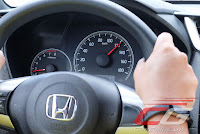Pause for a minute and imagine everything that a small car is. Ugly, terrible to drive, cramped—these are just some of the words used to describe what’s commonly considered as the lowest tier in motoring: the sub-compact or A-segment car. Now, open your eyes and see the 2019 Honda Brio. It’s the most affordable car in Honda’s stable, yet it manages to adhere to everything the Japanese carmaker stands for. It is, if you will, the “un-small small car.”
Everything starts with the styling. Compared to the startled look of the first-generation Brio, this new one looks every inch more refined. Lengthened by close to 200 millimeters, the stance is less awkward now. It keeps the front doors from the first-generation model, necessitating the continuation of that sharp side crease, though everything else is new. There are still some angles where it looks tall and skinny, but for the most part, it looks great. The Mobilio headlights do well to visually widen the front, despite the identical width with its predecessor, while the formal steel hatch at the back removes the sourness that most complained about before.
Improved as the Brio is from the back, it’s from the front where it truly shines. Borrowing the Mobilio’s angular dashboard, it’s straightforward to use. Compared to other sub-compacts out there, the seating position is lower and sportier, aided by a well-positioned meaty three-spoke steering wheel and easy-to-read gauges. Like the first-generation Brio, the seats have fixed headrests (except for the RS), but are comfy even for long drives. The Brio scores big for its sturdy construction, amount of storage spaces, and easy-to-use digital type air conditioner while it gets minus points for its tough-to-operate infotainment system (thankfully steering wheel controls are standard) and footrest omission.
Perhaps Honda’s gamble is their decision to swap the previous generation’s 1.3-liter engine for, get this, a 1.2-liter one. The downsized motor gives up 10 horsepower and 17 Nm of torque in a car that weighs just 1 kilogram lighter than before (22 kilograms more with the RS). On the surface, it seems Honda’s levying a performance penalty to make it more affordable, but thankfully, that’s not the case.
Getting the most out of the engine still requires wringing the accelerator, but it’s confident enough to hit the highways. It can feel taxed with three people and luggage onboard, but the engine isn’t at all vocal thanks to impressive NVH; plus it’s smooth and refined even at high rpms. Swapping the traditional automatic for an Earth Dreams CVT should have dulled the responses, but it's actually quite the opposite. It picks up speed pretty quickly, at least until the needle reaches 120 km/h. Fuel economy is also good, registering 14.5 km/L in a mixed city/highway route (about 10 km/L in the city).
With a carryover platform, that’s in turn, based off the first-generation Jazz, the Brio keeps its crown as the best handling A-segment car. The steering has this immediacy that the chassis could match. This tandem makes the Brio a great dance partner; the only car in this price range confident enough to tackle winding roads and sweeping corners. What’s even better is the ride hasn’t been affected at all; it’s actually softer than the previous generation while also being impervious to road cuts or potholes.
The name “Brio” means verve in Italian and with that, Honda’s managed to choose a very apt name. Just as the first-generation Brio presented itself as a fun-to-drive small car, this second-generation model successfully continuous that trend. Honda’s penchant for making a well-engineered car continues here, and with that, enthusiast will reap the benefits by having a choice with qualities that exceed its class.


























No comments:
Post a Comment
Feel free to leave your comment or share your views. Comments that are derogatory and/or spam will not be tolerated. We reserve the right to moderate and/or remove these comments.